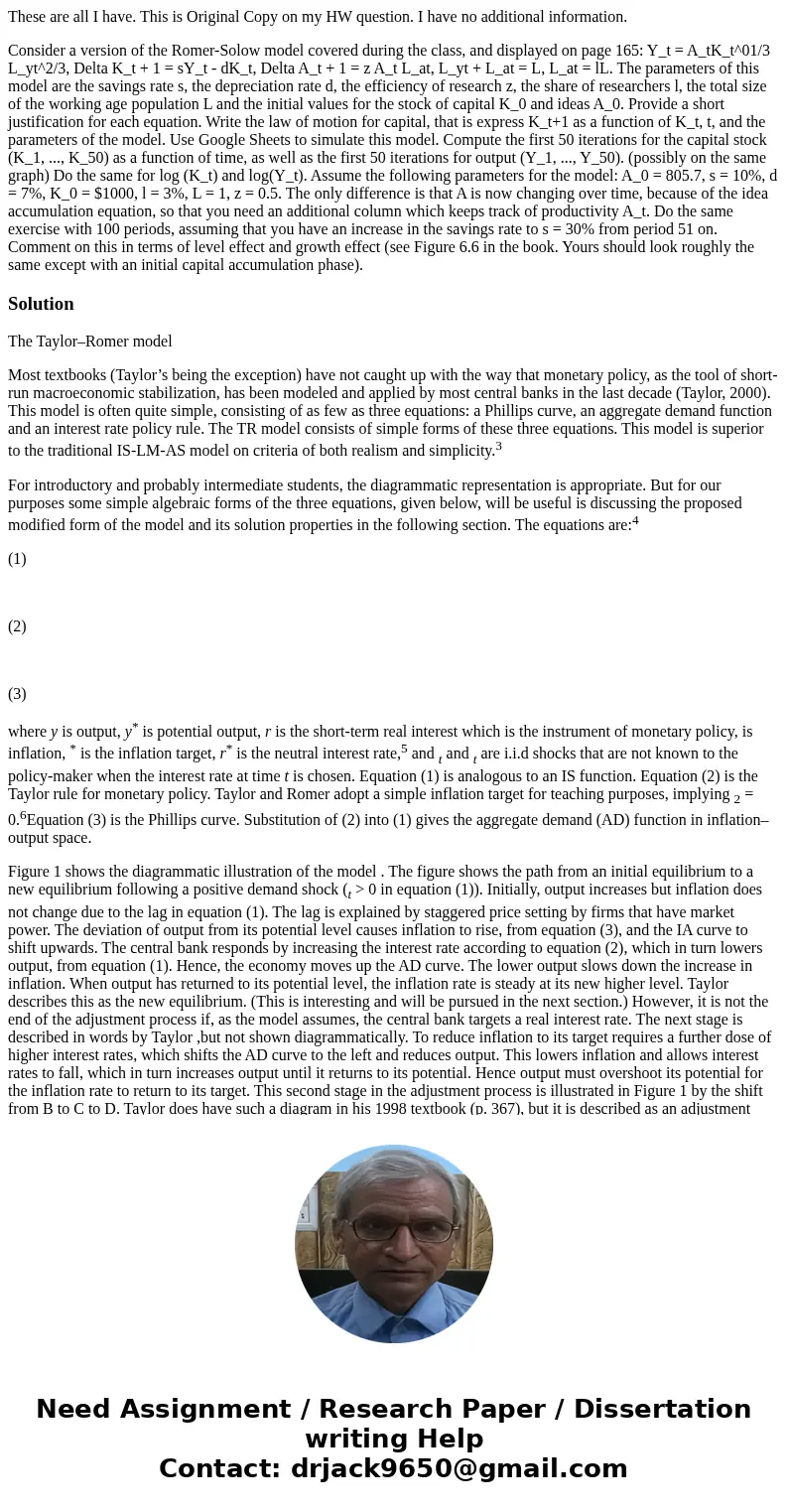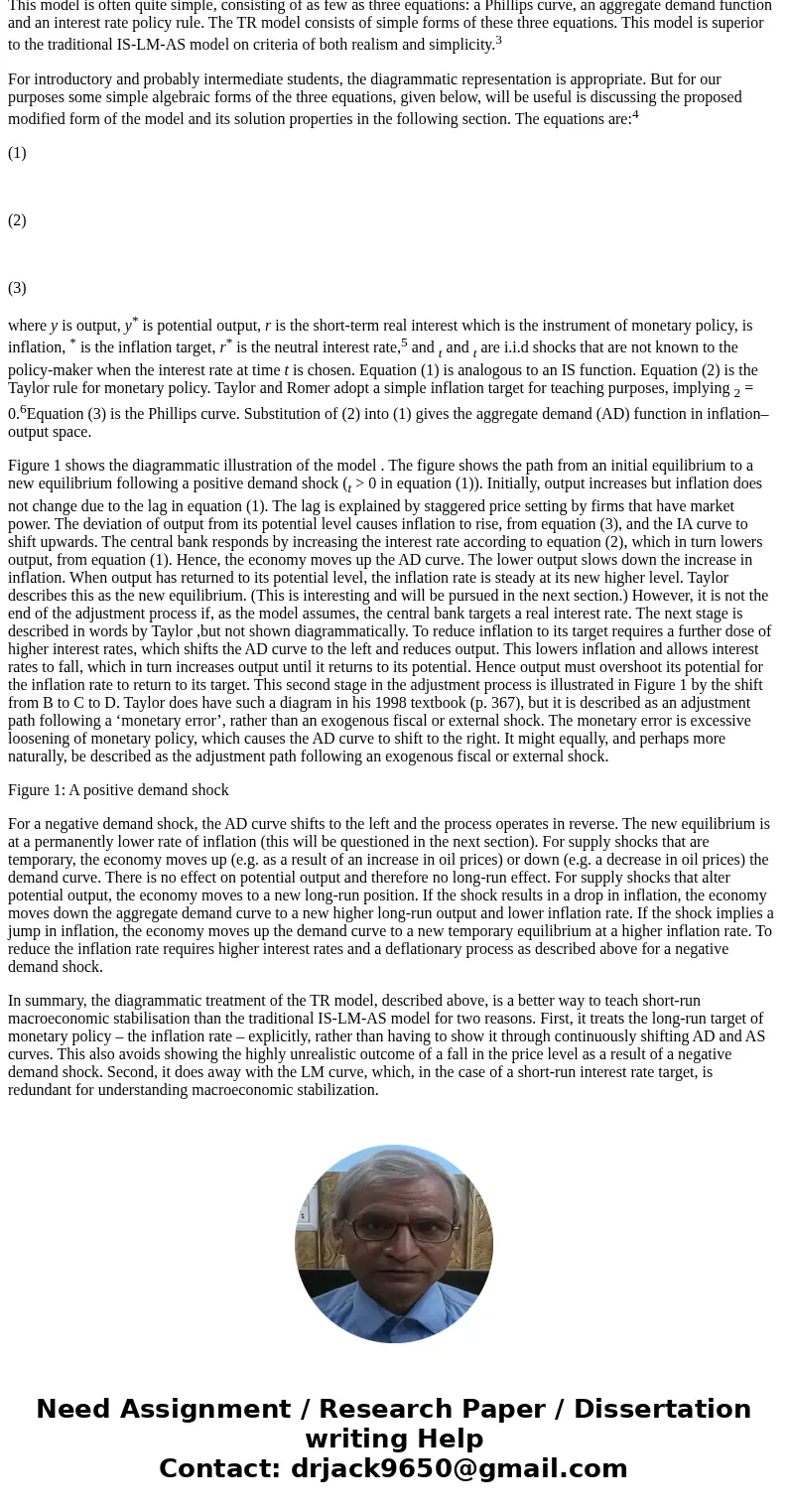These are all I have This is Original Copy on my HW question
These are all I have. This is Original Copy on my HW question. I have no additional information.
Consider a version of the Romer-Solow model covered during the class, and displayed on page 165: Y_t = A_tK_t^01/3 L_yt^2/3, Delta K_t + 1 = sY_t - dK_t, Delta A_t + 1 = z A_t L_at, L_yt + L_at = L, L_at = lL. The parameters of this model are the savings rate s, the depreciation rate d, the efficiency of research z, the share of researchers l, the total size of the working age population L and the initial values for the stock of capital K_0 and ideas A_0. Provide a short justification for each equation. Write the law of motion for capital, that is express K_t+1 as a function of K_t, t, and the parameters of the model. Use Google Sheets to simulate this model. Compute the first 50 iterations for the capital stock (K_1, ..., K_50) as a function of time, as well as the first 50 iterations for output (Y_1, ..., Y_50). (possibly on the same graph) Do the same for log (K_t) and log(Y_t). Assume the following parameters for the model: A_0 = 805.7, s = 10%, d = 7%, K_0 = $1000, l = 3%, L = 1, z = 0.5. The only difference is that A is now changing over time, because of the idea accumulation equation, so that you need an additional column which keeps track of productivity A_t. Do the same exercise with 100 periods, assuming that you have an increase in the savings rate to s = 30% from period 51 on. Comment on this in terms of level effect and growth effect (see Figure 6.6 in the book. Yours should look roughly the same except with an initial capital accumulation phase).Solution
The Taylor–Romer model
Most textbooks (Taylor’s being the exception) have not caught up with the way that monetary policy, as the tool of short-run macroeconomic stabilization, has been modeled and applied by most central banks in the last decade (Taylor, 2000). This model is often quite simple, consisting of as few as three equations: a Phillips curve, an aggregate demand function and an interest rate policy rule. The TR model consists of simple forms of these three equations. This model is superior to the traditional IS-LM-AS model on criteria of both realism and simplicity.3
For introductory and probably intermediate students, the diagrammatic representation is appropriate. But for our purposes some simple algebraic forms of the three equations, given below, will be useful is discussing the proposed modified form of the model and its solution properties in the following section. The equations are:4
(1)
(2)
(3)
where y is output, y* is potential output, r is the short-term real interest which is the instrument of monetary policy, is inflation, * is the inflation target, r* is the neutral interest rate,5 and t and t are i.i.d shocks that are not known to the policy-maker when the interest rate at time t is chosen. Equation (1) is analogous to an IS function. Equation (2) is the Taylor rule for monetary policy. Taylor and Romer adopt a simple inflation target for teaching purposes, implying 2 = 0.6Equation (3) is the Phillips curve. Substitution of (2) into (1) gives the aggregate demand (AD) function in inflation–output space.
Figure 1 shows the diagrammatic illustration of the model . The figure shows the path from an initial equilibrium to a new equilibrium following a positive demand shock (t > 0 in equation (1)). Initially, output increases but inflation does not change due to the lag in equation (1). The lag is explained by staggered price setting by firms that have market power. The deviation of output from its potential level causes inflation to rise, from equation (3), and the IA curve to shift upwards. The central bank responds by increasing the interest rate according to equation (2), which in turn lowers output, from equation (1). Hence, the economy moves up the AD curve. The lower output slows down the increase in inflation. When output has returned to its potential level, the inflation rate is steady at its new higher level. Taylor describes this as the new equilibrium. (This is interesting and will be pursued in the next section.) However, it is not the end of the adjustment process if, as the model assumes, the central bank targets a real interest rate. The next stage is described in words by Taylor ,but not shown diagrammatically. To reduce inflation to its target requires a further dose of higher interest rates, which shifts the AD curve to the left and reduces output. This lowers inflation and allows interest rates to fall, which in turn increases output until it returns to its potential. Hence output must overshoot its potential for the inflation rate to return to its target. This second stage in the adjustment process is illustrated in Figure 1 by the shift from B to C to D. Taylor does have such a diagram in his 1998 textbook (p. 367), but it is described as an adjustment path following a ‘monetary error’, rather than an exogenous fiscal or external shock. The monetary error is excessive loosening of monetary policy, which causes the AD curve to shift to the right. It might equally, and perhaps more naturally, be described as the adjustment path following an exogenous fiscal or external shock.
Figure 1: A positive demand shock
For a negative demand shock, the AD curve shifts to the left and the process operates in reverse. The new equilibrium is at a permanently lower rate of inflation (this will be questioned in the next section). For supply shocks that are temporary, the economy moves up (e.g. as a result of an increase in oil prices) or down (e.g. a decrease in oil prices) the demand curve. There is no effect on potential output and therefore no long-run effect. For supply shocks that alter potential output, the economy moves to a new long-run position. If the shock results in a drop in inflation, the economy moves down the aggregate demand curve to a new higher long-run output and lower inflation rate. If the shock implies a jump in inflation, the economy moves up the demand curve to a new temporary equilibrium at a higher inflation rate. To reduce the inflation rate requires higher interest rates and a deflationary process as described above for a negative demand shock.
In summary, the diagrammatic treatment of the TR model, described above, is a better way to teach short-run macroeconomic stabilisation than the traditional IS-LM-AS model for two reasons. First, it treats the long-run target of monetary policy – the inflation rate – explicitly, rather than having to show it through continuously shifting AD and AS curves. This also avoids showing the highly unrealistic outcome of a fall in the price level as a result of a negative demand shock. Second, it does away with the LM curve, which, in the case of a short-run interest rate target, is redundant for understanding macroeconomic stabilization.


 Homework Sourse
Homework Sourse